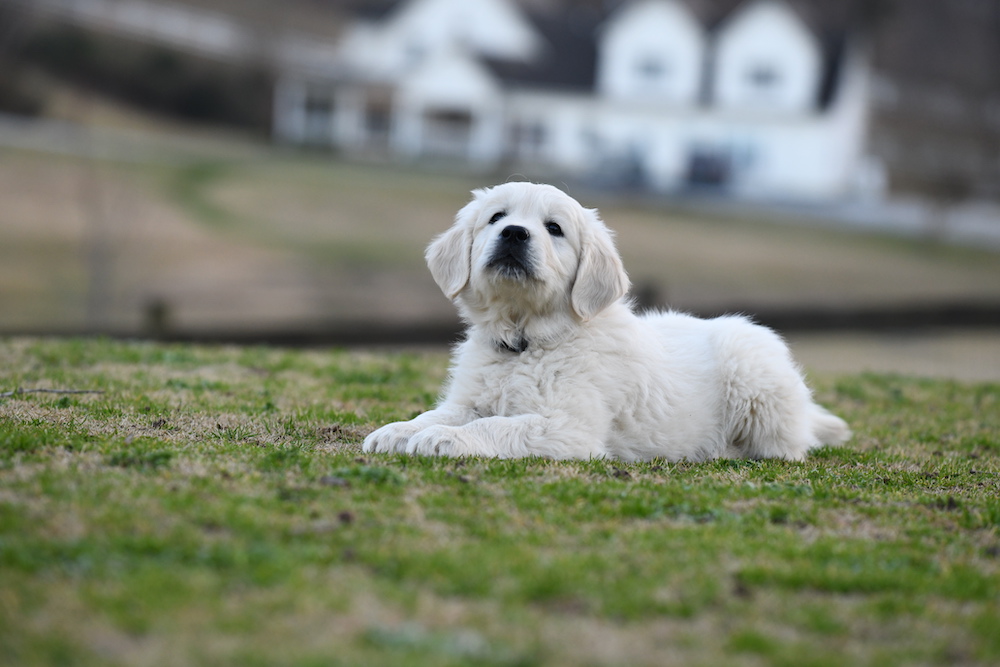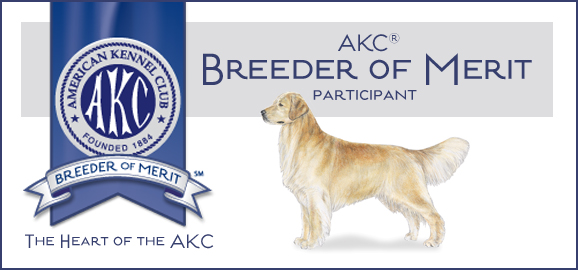This page discusses the training time line for our program. We have a very meticulously thought out program that takes advantage of the natural development of puppies. As much as possible, we try to work with our puppy’s natural instincts rather than against them. Our goal is to mold and modify these natural instinctual behaviors into behaviors more suitable for human cohabitation. For more information on our training program, see our Trained Puppies page and our Expectations page.

At the same time that we are shaping good behaviors, we are working toward another more important primary goal. This primary goal is to develop internal attributes in our puppies. These internal attributes include confidence, self-control, focus, resilience, and a desire to work with and please a person.
Learning from Others and Learning by Experience
We have learned what works and what doesn’t work by extensive reading, by watching videos of the best trainers in the world, and by talking to other trainers. I have a collection of almost 100 videos that I’ve watched repeatedly while staying up all night with young puppies. This “classroom” experience” has been valuable. However, it has been in the “classroom” of experience that I have learned the most.
My daughter Jenna and I love experimenting with new techniques and new methods and learning which work best with very young puppies. We’ve also experimented with which methods work best at which ages and with what ages are best for teaching various behaviors. We’ve trained well over a hundred puppies to focus, to build self-control, to love working with a person, and to build self-confidence. As we’ve focused on building these internal qualities in our puppies, we’ve also taught every one of these puppies to heel, to love a crate, to sit, down, stay, and to wait for food.
As we have “experimented” with these puppies, a very well-thought out time-line has been developed that takes full advantage of the natural developmental stages of puppies.
Training Time Line: Day By Day Instructions
For instance, we’ve learned that puppies learn best to use steps (only two or three at first), a doggy door, and to interact with other potentially scary things early before fear and excessive caution begins to creep in. However, if you teach them too early, they lack sufficient physical development.
Certain behaviors such as longer sit/stays and down/stays are learned much easier when a puppy is older and has a larger mental capacity and a greater ability for self-control.
Preliminary potty training is best done at a very specific age. In fact, we’ve pinned down the best age to the day. We can successfully train almost all puppies to pee and poop in a pan of pine pellets at 3 weeks 5 days of age if we spend the entire day focusing on it. However, at 3 weeks 4 days, we would be setting ourselves up for a day of frustration. Some puppies are just not quite mature enough for this work. It is “hit or miss”.
We learn that pottying outside is best taught beginning at about 4 1/2 weeks.
By trial and error, we’ve learned the optimum ages for teaching the various components of our training program. We have a very well thought out plan that is written down. Our plan has the details written down in a huge book. In addition, we have put together and follow a very large check off list that is by the exact age of our puppies to the day.
This web page is a summary of our training time line.
Training Time Line: What We Start Before 6 Weeks
Begin House Training Through a Doggy Door – By 5 1/2 Weeks
Most, if not all, of our puppies are fluent with a doggy door by 5 1/2 weeks of age. We are continuing to build consistency with outdoor pottying the entire time puppies are with us. We are consistent with making sure our puppies do all their business outside. It is rare for accidents to happen in our home with puppies over 8 or 9 weeks.
However, 10 week old puppies must be taken out (or crated) often. You can trust most our 10 week old puppies for about an hour loose in the house after they have gone potty. A few of them will need to be taken out every 30 minutes unless they are in a small pen or a crate. Some of them can be trusted for 1 1/2 – 2 hours at 10-11 weeks.
Though we never will say never, so far, we’ve not had a 10-week old puppy to pee or poop in a crate. However, we never leave them for over two hours straight until they are close to 12 weeks of age. At this age, we start them sleeping overnight in crates. We’ve never had a puppy over 12 weeks potty in a crate overnight. At 12 weeks, most can sleep in a crate for a 7 hour night.
Eating Individually in Crates – Starting at 5 1/2 Weeks
By 6 weeks, puppies have been eating individually in crates for about 4 or 5 days. They go into their crates on their own and are already starting to associate the crate with good things.
Training Time Line: Starting Right at or Just After 6 Weeks
Meal Time Manners
We work with puppies 3 times a day with our meal-time manners program starting shortly after they are 6 weeks. Our mealtime routine requires eye contact and waiting for a release command before eating. It is hugely beneficial with regard to building focus and self-control in puppies. At first, puppies struggle to get to their food, but within a few days, they begin getting the idea that they cannot get to their food until they get the release command. Further, they learn that the release command doesn’t come until puppies have settled down and given eye contact. This routine continues until puppies leave us. By 11 weeks, almost all puppies will wait with a bowl of food sitting in front of them giving good eye contact for a couple of seconds even with the crate door closed.
Begin Building Crate Desire
At about the same time as we begin our meal-time manners program, we begin building crate desire. We VERY GRADUALLY build up the time puppies are kept in crates, starting with only a few seconds.
We begin the process by dropping pieces of dog food kibble into the crates periodically. This process causes them to begin to anticipate that good things happen in crates. By 7 weeks, we add special bones and bully sticks that are only available at crate time. As puppies begin to get used to the crates, we gradually increase the time spent. We also gradually decrease the amount of kibble that we drop in the crates.
We work with our puppies in their crates when they are wide awake. This is the most difficult time for puppies to accept confinement. Teaching them to be happy while crated when wide awake is the hard part. Being happy in a crate while sleeping is easy.
Begin Teaching Puppies Not to Jump
Starting at 6 weeks, we begin waiting for puppies to quit jumping on us before we pet them. We don’t take them out of our puppy area for individual attention until they stop jumping. We gradually increase our expectations. By 8 weeks, we are choosing to only pick up or pet the puppies that are sitting with eye contact. This continues until puppies leave us. Once we take a puppy away from litter-mates, jumping is minimal.
Sitting for attention is the norm with our puppies by the time they are 10-weeks of age. If a person does not give our puppies attention, most will try other good behaviors such as going into a down or sitting in different positions (in front or at your side). However, if the person still doesn’t give one of our puppies attention after the puppy has given much effort toward properly asking for attention, most, if not all will resort to jumping. Good behavior must be rewarded for it to continue.
Begin Formal Obedience
Starting after 6 weeks, we begin daily individual formal obedience training. We spend the first few days working solely on focus as we teach our puppies to make eye contact. Puppies earn their reward by simply sitting and making eye contact.
Begin Teaching the Down
Starting at about 6 1/2 weeks, we begin teaching what we call muscle memory. We do this as we teach our puppies to “down”. No command is given. We simply teach the puppies to be lured to the “down” position. As we teach this, puppies learn several other skills at the same time. Puppies learn to gently take treats from us. They increase their skills with regard to maintaining eye contact. Puppies learn to follow a treat.
Though we do the initial training of the “down” with luring, within a couple of days, we shift our training method to shaping. With shaping, the treat is not shown until after the behavior is performed.
Time Line Starting at 7 1/2 Weeks (After Puppy Selection)
Begin to Teach Heeling to Those Puppies in Our Heeling Program
By the time puppies are 7 weeks of age, we’ve trained them to sit while maintaining good eye contact at our side. Once solid, we begin teaching puppies to move one step. We practice rewarding our puppies for simply sitting still and maintaining eye contact hundreds of times before we ask them to move. Then we practice what we call “one-step-and-sits” even more.
We begin our work heeling on a fence to help puppies stay close to us and straight. Eventually we move them off the fence and teach them to stay in position without the aid of a fence. Our philosophy of training is to train the basics well before adding distance, duration, or distractions to our work.
Begin Teaching the Down/Stay and Teaching Puppies to Differentiate Between Commands
This is the one area of our program that varies from puppy to puppy. The order that we teach puppies to differentiate between the sit and the down and to acclimate to our moving away from them is not the same for one puppy as it might be for another.
Instead, we’ve found it beneficial in this area to follow the inclinations of the puppy. Some puppies are easier to teach one way. Others do better with another technique or on a different time line. Some mature faster in one area. Others mature faster in another.
Part of being a good trainer is knowing your puppies and having a large “toolbox” of methods and techniques for teaching behaviors and solving problems that will inevitably come up.
After 8 Weeks
You can get a pretty good idea of our training time line after 8 weeks by reading our Expectations Page.

